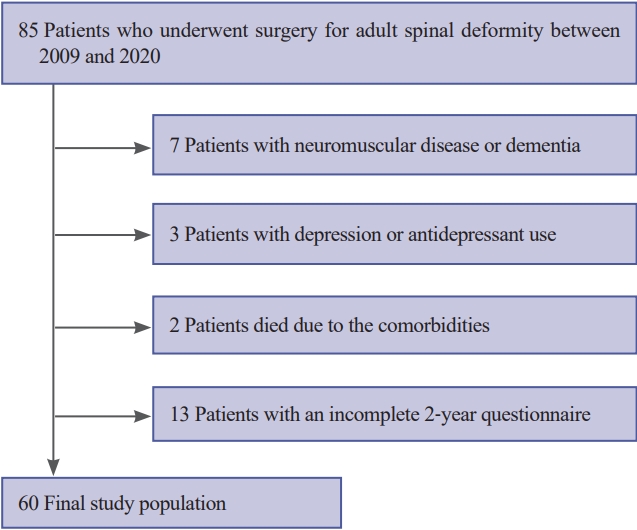1. Schwab F, Ungar B, Blondel B, et al. Scoliosis Research Society-Schwab adult spinal deformity classification: a validation study. Spine (Phila Pa 1976) 2012;37:1077ŌĆō82.

2. Schwab F, Lafage V, Patel A, Farcy JP. Sagittal plane considerations and the pelvis in the adult patient. Spine (Phila Pa 1976) 2009;34:1828ŌĆō33.


3. Yamato Y, Hasegawa T, Kobayashi S, et al. Calculation of the target lumbar lordosis angle for restoring an optimal pelvic tilt in elderly patients with adult spinal deformity. Spine (Phila Pa 1976) 2016;41:E211ŌĆō7.


5. Schwab F, Blondel B, Chay E, et al. The comprehensive anatomical spinal osteotomy classification. Neurosurgery 2014;74:112ŌĆō20.


6. Matsumura A, Namikawa T, Kato M, Hori Y, Hidaka N, Nakamura H. Factors related to postoperative coronal imbalance in adult lumbar scoliosis. J Neurosurg Spine 2020;34:66ŌĆō72.


7. Seyed Vosoughi A, Joukar A, Kiapour A, et al. Optimal satellite rod constructs to mitigate rod failure following pedicle subtraction osteotomy (PSO): a finite element study. Spine J 2019;19:931ŌĆō41.


9. Hosogane N, Watanabe K, Yagi M, Kaneko S, Toyama Y, Matsumoto M. Scoliosis is a risk factor for gastroesophageal reflux disease in adult spinal deformity. Clin Spine Surg 2017;30:E480ŌĆō4.


10. Glassman SD, Berven S, Bridwell K, Horton W, Dimar JR. Correlation of radiographic parameters and clinical symptoms in adult scoliosis. Spine (Phila Pa 1976) 2005;30:682ŌĆō8.


11. Scheer JK, Smith JS, Clark AJ, et al. Comprehensive study of back and leg pain improvements after adult spinal deformity surgery: analysis of 421 patients with 2-year follow-up and of the impact of the surgery on treatment satisfaction. J Neurosurg Spine 2015;22:540ŌĆō53.


12. Fu KM, Bess S, Shaffrey CI, et al. Patients with adult spinal deformity treated operatively report greater baseline pain and disability than patients treated nonoperatively; however, deformities differ between age groups. Spine (Phila Pa 1976) 2014;39:1401ŌĆō7.


13. Riley MS, Bridwell KH, Lenke LG, Dalton J, Kelly MP. Health-related quality of life outcomes in complex adult spinal deformity surgery. J Neurosurg Spine 2018;28:194ŌĆō200.


14. Arima H, Hasegawa T, Yamato Y, et al. Clinical outcomes of corrective fusion surgery from the thoracic spine to the pelvis for adult spinal deformity at 1, 2, and 5years postoperatively. Spine (Phila Pa 1976) 2022;47:792ŌĆō9.


15. Bridwell KH, Shufflebarger HL, Lenke LG, Lowe TG, Betz RR, Bassett GS. ParentsŌĆÖ and patientsŌĆÖ preferences and concerns in idiopathic adolescent scoliosis: a cross-sectional preoperative analysis. Spine (Phila Pa 1976) 2000;25:2392ŌĆō9.

16. Koch KD, Buchanan R, Birch JG, Morton AA, Gatchel RJ, Browne RH. Adolescents undergoing surgery for idiopathic scoliosis: how physical and psychological characteristics relate to patient satisfaction with the cosmetic result. Spine (Phila Pa 1976) 2001;26:2119ŌĆō24.

18. Weiss HR, Reichel D, Schanz J, Zimmermann-Gudd S. Deformity related stress in adolescents with AIS. Stud Health Technol Inform 2006;123:347ŌĆō51.

19. Simmons ED. Surgical treatment of patients with lumbar spinal stenosis with associated scoliosis. Clin Orthop Relat Res 2001;(384):45ŌĆō53.


20. Hori Y, Matsumura A, Namikawa T, Kato M, Iwamae M, Nakamura H. Comparative study of the spinopelvic alignment in patients with idiopathic lumbar scoliosis between adulthood and adolescence. World Neurosurg 2021;149:e309ŌĆō15.


22. Watanabe K, Ohashi M, Hirano T, et al. Health-related quality of life in nonoperated patients with adolescent idiopathic scoliosis in the middle years: a mean 25-year followup study. Spine (Phila Pa 1976) 2020;45:E83ŌĆō9.

23. Bridwell KH, Lenke LG, Cho SK, et al. Proximal junctional kyphosis in primary adult deformity surgery: evaluation of 20 degrees as a critical angle. Neurosurgery 2013;72:899ŌĆō906.

24. Fukuhara S, Bito S, Green J, Hsiao A, Kurokawa K. Translation, adaptation, and validation of the SF-36 Health Survey for use in Japan. J Clin Epidemiol 1998;51:1037ŌĆō44.


25. Arima H, Carreon LY, Glassman SD, et al. Cultural variations in the minimum clinically important difference thresholds for SRS-22R after surgery for adult spinal deformity. Spine Deform 2019;7:627ŌĆō32.


26. R Development Core Team. R: a language and environment for statistical computing. Vienna: R Foundation for Statistical Computing; 2009.
27. Raad M, Jain A, Huang M, et al. Validity and responsiveness of PROMIS in adult spinal deformity: the need for a selfimage domain. Spine J 2019;19:50ŌĆō5.


29. Smith PL, Donaldson S, Hedden D, et al. ParentsŌĆÖ and patientsŌĆÖ perceptions of postoperative appearance in adolescent idiopathic scoliosis. Spine (Phila Pa 1976) 2006;31:2367ŌĆō74.


30. DŌĆÖAndrea LP, Betz RR, Lenke LG, et al. Do radiographic parameters correlate with clinical outcomes in adolescent idiopathic scoliosis? Spine (Phila Pa 1976) 2000;25:1795ŌĆō802.












